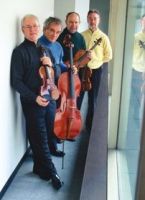
Juilliard Quartet Combines a Vist with a Farewell
Chamber Music Cincinnati hosted a distinguished visitor, the Juilliard String Quartet, Tuesday night in Corbett Auditorium at the University of Cincinnati College-Conservatory of Music.

It was also a farewell of sorts. First violinist Joel Smirnoff, named president of the Cleveland Institute of Music last summer, is making his last tour with the ensemble. A member of the Quartet since 1986 and first violinist since 1997, Smirnoff will be succeeded in July by Nick Eanet.
Smirnoff and his colleagues, second violinist Ronald Copes, violist Samuel Rhodes and cellist Joel Krosnick brought a generous program with them. It was a three-century spread, with Haydn’s Quartet in C Major, Op. 20, No. 2 (1772), Beethoven’s Quartet Op. 127 (1824) and Henri Dutilleux’ “Ainsi la Nuit” for String Quartet (1976).
The program was well-crafted stylistically, with each work representing a new departure for its composer.
Haydn, father of the string quartet, made defining moves is his six Op. 20 quartets that would establish the model for the form, such as equal treatment of the instruments and structural use of polyphony (the finale of Op. 20, No. 2 is a fugue, for instance).
Beethoven’s Op. 127 is the first of his late string quartets, written after a 12-year gap from his earlier quartets and stylistically quite different.
“Ainsi la Nuit,” composed for the Juilliard Quartet, was Dutilleux’ first (and so far only) string quartet.
The lineage of the three works is clear, too, with Haydn directly influencing Beethoven, and Dutilleux, as have all composers since Beethoven’s time, looking to him for inspiration.
There is a heightened emotional element in the three quartets. Haydn’s, as CCM doctoral student Albert Mühlböck observed in his excellent pre-concert lecture, was influenced by the contemporaneous “Sturm und Drang” movement in literature. Exemplified by Goethe’s writings, this reaction to the Enlightenment elevated feeling over intellectualism. Beethoven’s late quartets are intensely personal, while the expressive quality of Dutilleux quartet is clear, if non-specific.
The delectable sound and pinpoint ensemble of the Juilliard were manifest in the opening bars of the Haydn, which poured forth sweetly, then took a somber turn in the plaintive, minor-key Adagio. The quirky Menuetto gave way to a fully collegial finale, where the four musicians traded lines with aplomb for an extraordinary impression.
“Ainsi la nuit” (“Thus the night”) doesn’t reveal itself easily, being tightly woven into an intricate design, utilizing harmony, motif, gesture and color as unifying elements. Intent on employing the full range of effects possible on stringed instruments, the composer submitted sketches or “nuits” to the Juilliard Quartet in advance. And what a rainbow it is, with pizzicato, harmonics, glissandi, tremolo, playing on or behind the bridge, etc. plus the sheer beauty of natural bowing. Smirnoff excused himself at the very beginning to retrieve his glasses backstage. “For this piece, you need them,” he said.
There are seven movements of one to three minutes’ duration each, with titles like “Nocturne,” “Miroir d’espace,” “Litanies,” “Constellations” and finally “Temps suspendu.” Dutilleux attached no overt meaning to these names, but an evocation of night – even a cosmic or spiritual orientation – is highly implied. Separating the first five are brief “parentheses” of 20-40 seconds which the composer has described as “reservoirs” in which the materials of the work are recalled or anticipated. (Knowledge of French writer Marcel Proust’s concept of involuntary memory, such as the taste of the cookie that instantly reminded him of his grandmother, is instructive here.)
Actually comprehending this as it happens is very difficult, so just letting the music wash over you and do its spell is best. It is also very rewarding, particularly in a live performance, where you can watch the players.
The influence of Stravinsky shone through at various times, as did that of Bartok (his characteristic “night music” in particular). The opening chord of the Introduction, a unifying element, returned in “Litanies 1” like a hammer chord from “Rite of Spring.” Echoes of “Firebird” flitted through “Miroir d’espace.” There were moments of breathtaking beauty, as in “Litanies 2,” where the instruments, with Smirnoff and Copes sometimes off in the stratosphere, spun ethereal lines.
Just into “Constellations” there was a loud popping noise, which turned out to be a string breaking on Krosnick’s cello. After a brief exit to replace it, the celestial motion continued, busy and unabated, until the final “Nocturne 2” and “Temps suspendu,” where Krosnick executed some gorgeous fingered harmonics, the music floated upward, and then dissolved in a soft puff of sound.
Dutilleux was a hard act to follow, even for Beethoven, whose Op. 127 concluded the evening. The utmost unity and communication of the Juilliard were manifest here, with the listener having to look sometimes to tell whether Smirnoff or Copes were playing -- or for that matter, Rhodes or Krosnick, so mellow was Krosnick’s tone in its middle and upper register.
The Andante theme and variations (at 16 minutes, almost as long as the other three movements combined) was a lovely outpouring. The strenuous, dotted-rhythm Scherzando was a workout where the players seemed to tire a bit, but their energy reserve held up admirably in the Allegro finale, which brought the concert to a high-spirited close.
With the audience on its feet, the Quartet performed an encore, the finale of Haydn’s Quartet in F Minor, Op. 20, No. 5. Though more “serious” in tone than his Op. 20, No. 2 heard earlier in the evening, this quartet, too, ends with a fugue.